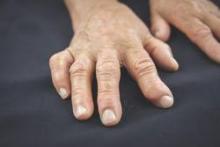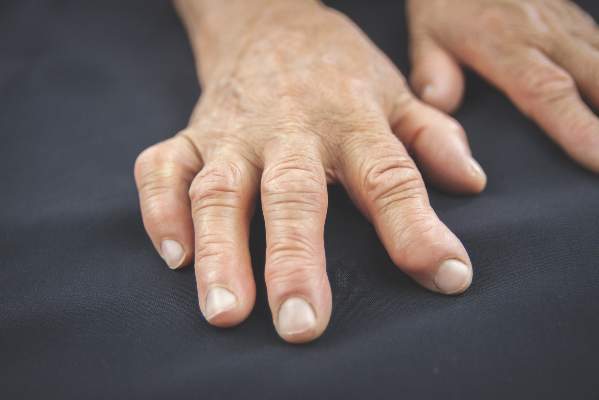User login
Baseline assessment of patients with undifferentiated arthritis at an early disease stage with the multibiomarker disease activity score did not discriminate patients who continued to have undifferentiated disease at 2 years from those who met classification criteria for rheumatoid arthritis in a prospective cohort study.
Tender joint count based on 68 joints at baseline and female sex, but not the multibiomarker disease activity (MBDA) score, were significant predictors of developing rheumatoid arthritis (RA) in the study of 45 patients who had undifferentiated arthritis (UA) and 81 who had RA based on 2010 American College of Rheumatology (ACR)/European League Against Rheumatism (EULAR) classification criteria, Dr. Karen I. Maijer of the University of Amsterdam and her colleagues reported.
At baseline, all the patients had one or more swollen joints, had clinical symptoms for less than 1 year, and had never taken disease-modifying antirheumatic drugs or corticosteroids. Following evaluation and serum collection, the patients were treated according to EULAR guidelines. Of the 45 with UA, 29 continued to have UA at 2-year follow-up and 16 developed RA.
The results of the study indicated, however, that the baseline MBDA scores were higher in patients with an initial RA diagnosis than in those with UA, which is consistent with its validation in tracking disease activity in RA patients.
Read the full study in Annals of the Rheumatic Diseases (2015 Sept. 2 doi: 10.1136/annrheumdis-2015-207911).
Baseline assessment of patients with undifferentiated arthritis at an early disease stage with the multibiomarker disease activity score did not discriminate patients who continued to have undifferentiated disease at 2 years from those who met classification criteria for rheumatoid arthritis in a prospective cohort study.
Tender joint count based on 68 joints at baseline and female sex, but not the multibiomarker disease activity (MBDA) score, were significant predictors of developing rheumatoid arthritis (RA) in the study of 45 patients who had undifferentiated arthritis (UA) and 81 who had RA based on 2010 American College of Rheumatology (ACR)/European League Against Rheumatism (EULAR) classification criteria, Dr. Karen I. Maijer of the University of Amsterdam and her colleagues reported.
At baseline, all the patients had one or more swollen joints, had clinical symptoms for less than 1 year, and had never taken disease-modifying antirheumatic drugs or corticosteroids. Following evaluation and serum collection, the patients were treated according to EULAR guidelines. Of the 45 with UA, 29 continued to have UA at 2-year follow-up and 16 developed RA.
The results of the study indicated, however, that the baseline MBDA scores were higher in patients with an initial RA diagnosis than in those with UA, which is consistent with its validation in tracking disease activity in RA patients.
Read the full study in Annals of the Rheumatic Diseases (2015 Sept. 2 doi: 10.1136/annrheumdis-2015-207911).
Baseline assessment of patients with undifferentiated arthritis at an early disease stage with the multibiomarker disease activity score did not discriminate patients who continued to have undifferentiated disease at 2 years from those who met classification criteria for rheumatoid arthritis in a prospective cohort study.
Tender joint count based on 68 joints at baseline and female sex, but not the multibiomarker disease activity (MBDA) score, were significant predictors of developing rheumatoid arthritis (RA) in the study of 45 patients who had undifferentiated arthritis (UA) and 81 who had RA based on 2010 American College of Rheumatology (ACR)/European League Against Rheumatism (EULAR) classification criteria, Dr. Karen I. Maijer of the University of Amsterdam and her colleagues reported.
At baseline, all the patients had one or more swollen joints, had clinical symptoms for less than 1 year, and had never taken disease-modifying antirheumatic drugs or corticosteroids. Following evaluation and serum collection, the patients were treated according to EULAR guidelines. Of the 45 with UA, 29 continued to have UA at 2-year follow-up and 16 developed RA.
The results of the study indicated, however, that the baseline MBDA scores were higher in patients with an initial RA diagnosis than in those with UA, which is consistent with its validation in tracking disease activity in RA patients.
Read the full study in Annals of the Rheumatic Diseases (2015 Sept. 2 doi: 10.1136/annrheumdis-2015-207911).

